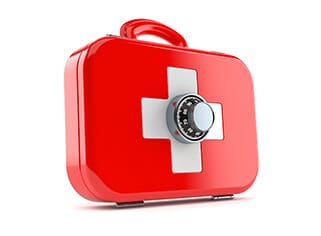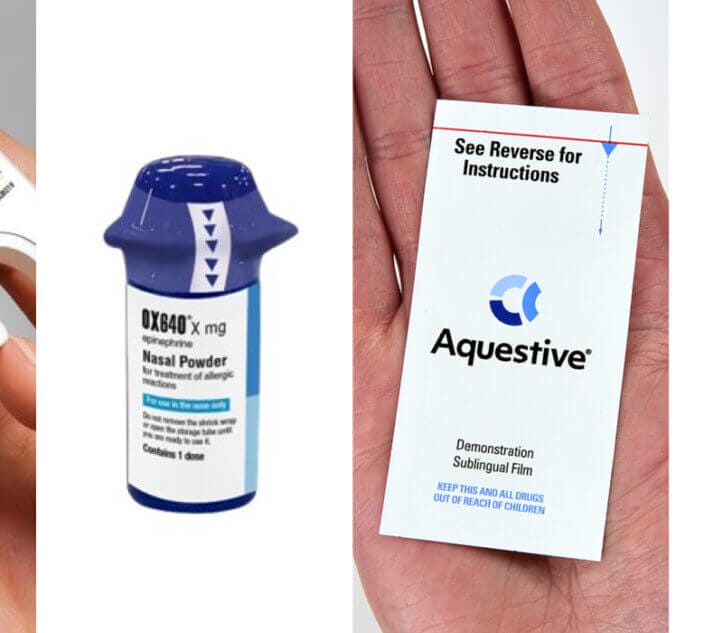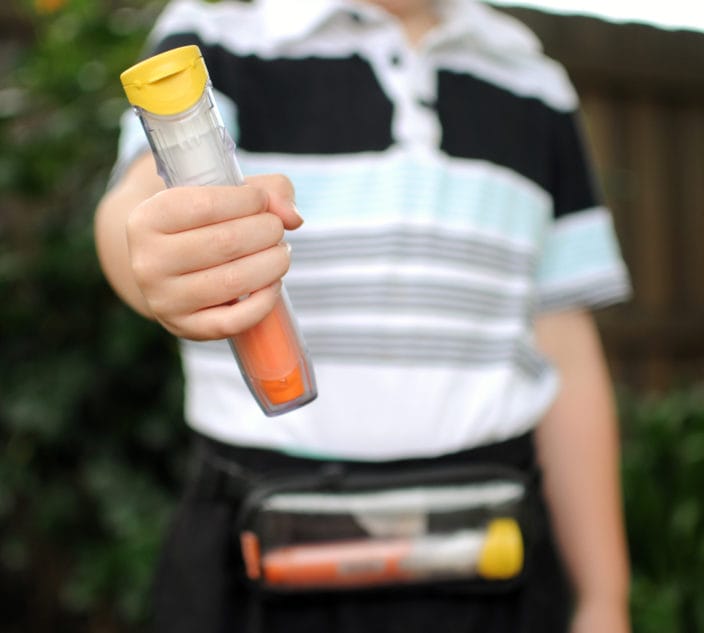
When my son was 8, I went to school early one day to add some aloe cream to his medical kit in the school nurse’s office. He had enrolled in the Viaskin Peanut Patch trial and his teacher told me he was feeling itchy around the patch site.
At the nurse’s office, our regular nurse was out sick. I watched in horror as the substitute nurse took more than 15 minutes to find the key to the cabinet that housed the student medical kits and then additional time to locate my son Joshua’s specific kit. Clearly, if he had needed his epinephrine auto-injector that day, it was not going to be found and administered quickly.
With my pulse rate up, I immediately sought out our principal. I pulled up a few Allergic Living articles on my phone and emailed them to him on my walk over to his office. This was to bolster my assertation that, when dealing with allergic reactions, minutes, even seconds, matter. It was vital to show him what can happen when epinephrine is not administered quickly. He read the articles on tragedies somberly, understanding my grave concerns.
At Josh’s school, this led to changes in how the medication was stored – the epinephrine is no longer locked up. Also, additional undesignated auto-injectors were placed around the building.
I shared this school experience recently on my No Nut Traveler Facebook page, to remind folks to check with their own schools to see if medications for their children are kept in locked or unlocked cabinets. As the comments grew on my post, so did my concern and outrage.
Epinephrine Locked in Another Building
Many commenters relayed a similar situation to mine at school. Medications were stored in a locked cabinet and other staff sometimes didn’t know the key’s location. Kim Peicker shared an issue with her school when her son was in a summer program for speech therapy.
“On the last day of the program, I went to pick up the EpiPen and the nurse had left early,” she wrote. “The door was locked and then the office staff didn’t know where it was (in a locked file cabinet). It took 10 to 15 minutes to find it. This is a very real issue.”
As food allergy parents, we send our kids out into the world each day worried that an ordinary food can cause them to go into anaphylaxis. Much of a child’s day are spent in school, and having the right medications quickly and easily accessible becomes a critical point.
Follower Pam Bass said a few years ago, she asked her daughter’s art teacher “to walk me through” how she would get access to her child’s auto-injector. It took over 15 minutes. They walked from the elementary school’s art room to another building. They unlocked that door, went to the nurse’s office (also locked), then ultimately got to the locked cabinet with the medication.
“We immediately changed to self-carrying,” she said. A few parents similarly shared concerning episodes of finding asthma inhalers locked up.
Others wrote that they’d faced resistance at school to their child self-carry their epinephrine auto-injectors. Yet, not every school has a nurse, or in large schools, the nurse may be in a different building. In some districts, the school nurse may rotate her days through a few schools.
Locked Up Meds: How to Counter
On self-carrying, one mom faced immense pushback. “It drives me crazy when they tell me that the epinephrine in my son’s allergy bag is dangerous to other kids.” The pushback was the impetus for her not to back down about self-carrying medication.
I must add that, in years of food allergy advocacy, I have never heard of a situation where an epinephrine auto-injector has harmed another child or adult.
So what can parents do to ensure epinephrine is accessible and not locked up in the event of an allergic reaction at school? Jen Jobrack, a national food allergy expert, stresses that, before the school year starts, parents need to familiarize themselves with their state’s laws regarding food allergies. Many states require school districts to have food allergy management guidelines.
“Read it, learn it, and know it,” says Jobrack, founder of Food Allergy Pros LLC. Only then can you accurately make sure it’s being enforced.
Ask questions such as where the school keeps epinephrine for students and who has access to it before the school year begins. Jobrack’s recommendation is that if the school does keep auto-injectors under lock and key, then you should “ensure the placement of the auto-injector is in their child’s 504 plan, which is a legal document.” Getting a 504 disability plan takes time, negotiation and planning, so start early.
“Students with known allergies should have easy access to epinephrine, whether they self-carry or it is safely stored, unlocked but supervised, within the school,” says Robin Cogan, a nationally certified school nurse. Cogan, known in social media as “the relentless school nurse,” emphasizes that the parent and school nurse are a team. “Your child is less likely to be exposed to allergens at school when we work together to create a management plan for your child,” she says.
Locked Up Epinephrine vs. Self-Carry
Cogan echoes the need for planning. She suggests reaching out to your school nurse before school begins to go over any important details or concerns.
When it comes to kids who are capable of self-carrying medications, Jobrack says the law is on food allergy parents’ side. “Every state has laws on the books that require schools in that state to allow students to carry epinephrine,” says Jobrack.
The wording of such laws varies from state to state. It is her suggestion that all parents review their own state laws – because a school is not going to volunteer whether they are knowingly or unknowingly abiding by state law. The first obligation of the parent advocate is to research the policies.
Cogan told me the students right to self-carry is usually contained within the student’s medication administration order, which is signed by a physician. Some states, however, have a separate form. In New Jersey, where she is based, “We can also delegate the use of epinephrine in an emergency with a child/staff with unknown anaphylaxis.”
My son also goes to school in New Jersey and at his school, they keep the undesignated auto-injectors on the wall throughout the building in case of an emergency.
We certainly can’t always rely on a school having a school nurse, as there’s a national shortage. In a 2017 survey, only 40 percent of public schools had a school nurse, with a high rate leaving the profession over burnout, inadequate pay, patient load and more. Since the COVID-19 pandemic, reports suggest many more have left the profession.
Cogan says many school nurses resigned, retired or took early retirement during the pandemic period. “There are many vacancies, and it is weighing heavily on our school nurse workforce.”
Unlocked Epi is Vital to Safety
To explain why we must use epinephrine promptly in a serious reaction, allergist Dr. Hugh Sampson uses the analogy of a snowball rolling down a hill.
When it’s up at the top, it’s easier to stop because it is small, he often tells parents. As the ball rolls down, it gains snow and grows, becoming more challenging to stop. Studies show that treating anaphylaxis early leads to better outcomes.
Food is all around kids with food allergies. No schools are free of food. Most children eat at least one meal at school and some classroom activities also involve food. They play after-school sports or take part in band, cheer or debate outings. The potential minefields are limitless.
That is why epinephrine must be accessible to be used quickly in the event of anaphylaxis. Locking up medications as well as limiting the school staffs’ access to keys and auto-injectors sets the stage for potential disaster. I believe it is critical that undesignated epinephrine auto-injectors be in every school with unfettered access.
All staff must be trained on auto-injectors. Back when Josh was a kindergartener, he was able to train his whole class, as he told me, to “save him.” It seems that simple because it is.
Lianne Mandelbaum is Allergic Living’s airlines correspondent, and the founder of the nonprofit NoNutTraveler.com.
Related Reading:
Food Allergies at School: the Plans, the Laws to Keep Kids Included
School with Food Allergies: 7 Must-Have Tools
Gina Clowes: Getting What You Need on Allergies at School





